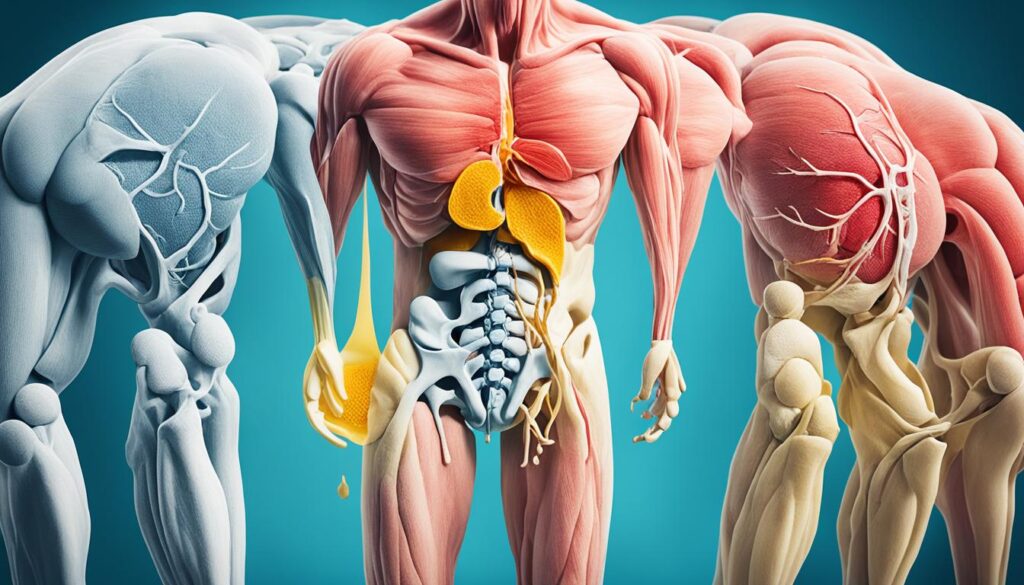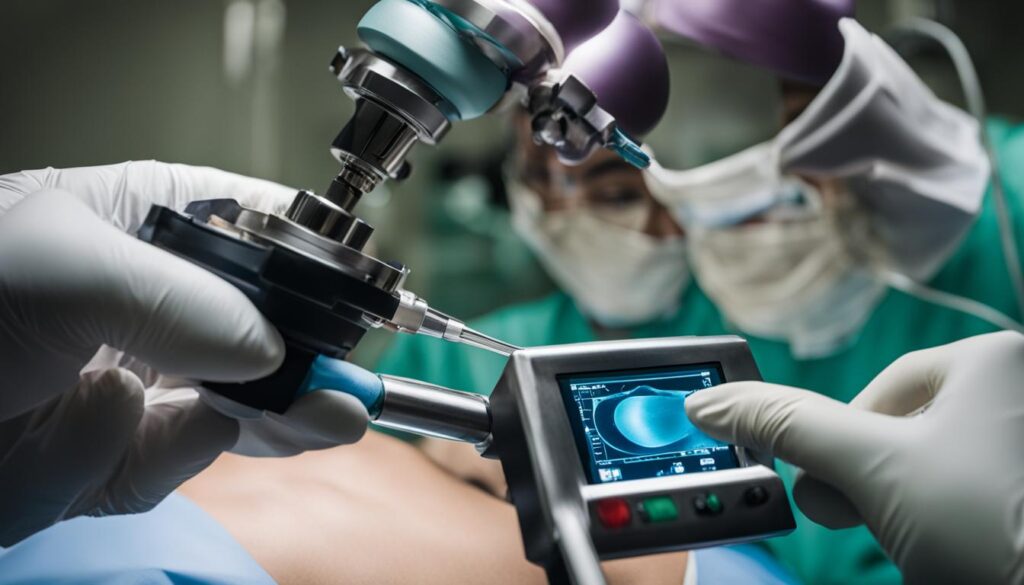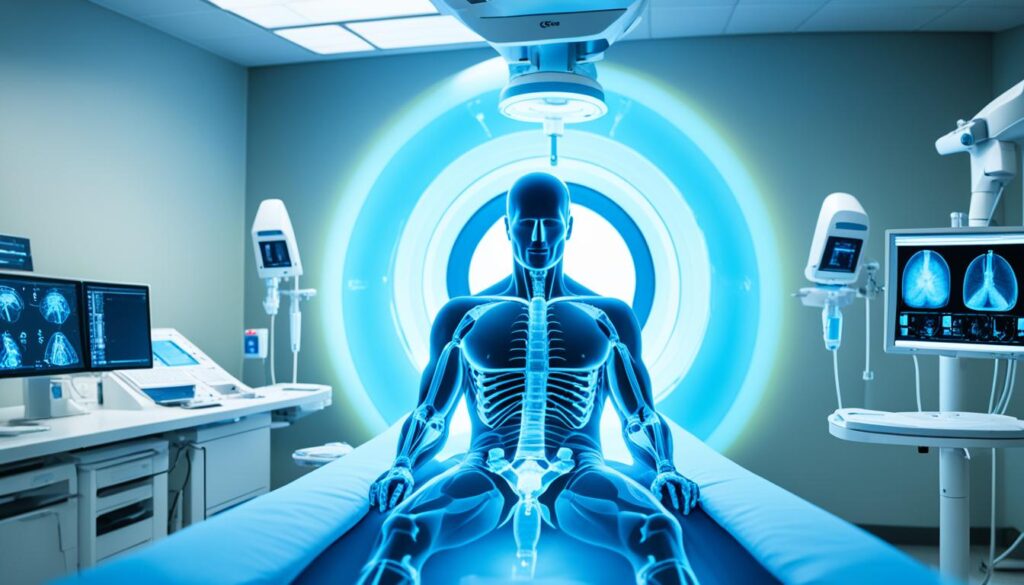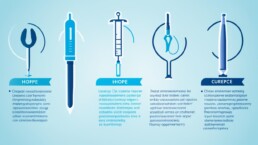Medically reviewed by Dr Chandril Chugh,
Renowned Neurologist and American Trained Specialist
Prostate cancer is a significant health concern for men worldwide. Detecting the symptoms of prostate cancer early is essential for taking timely action and achieving better health outcomes. In this article, we will explore the various symptoms of prostate cancer that men should be aware of, providing you with the knowledge to detect any warning signs early.
Table of Contents
ToggleKey Takeaways:
- Familiarize yourself with the common symptoms of prostate cancer in men
- Early detection of symptoms allows for timely action and better health outcomes
- Symptoms such as urinary retention, impotence, frequency, hesitancy, nocturia, haematuria, weight loss, and abnormal rectal examination may indicate prostate cancer but can also be caused by other conditions
- Consult with a healthcare professional if you experience any of these symptoms
- Early diagnosis of prostate cancer is crucial for reducing mortality and tumor progression
Common Symptoms of Prostate Cancer
Prostate cancer is a prevalent condition that affects men worldwide. Early detection is crucial for successful treatment and improved outcomes. Understanding the common symptoms associated with prostate cancer can help you identify potential warning signs and seek timely medical attention. While these symptoms may not always indicate prostate cancer, they warrant further investigation to rule out any serious underlying conditions.
Please note that if you experience any of the following symptoms, it is important to consult with a healthcare professional for a proper diagnosis and appropriate management:
- Urinary retention: Difficulty in fully emptying the bladder
- Impotence: Difficulty in achieving or maintaining an erection
- Frequency: Increased need to urinate more often than usual
- Hesitancy: Difficulty initiating urine flow
- Nocturia: Frequent urination during the night
- Haematuria: Presence of blood in the urine
- Weight loss: Unexplained and unintentional weight loss
- Abnormal rectal examination: Detection of irregularities or abnormalities during a rectal examination

A population-based case-control study revealed that these symptoms were commonly associated with prostate cancer. However, it is important to remember that experiencing one or more of these symptoms does not automatically indicate prostate cancer, as they can also be caused by other conditions. Consulting with a healthcare professional is essential to receive a proper diagnosis and appropriate treatment.
Importance of Early Diagnosis
Early diagnosis plays a crucial role in the effective management of prostate cancer. Detecting the cancer at an early stage allows for timely treatment, leading to better health outcomes and improved prognosis. Studies have shown that early surgical intervention for prostate cancer offers numerous benefits, including a reduction in mortality rates, prevention of local tumor progression, and a decreased risk of metastases.
Prostate cancer is a slow-growing disease, and symptoms may not manifest until the cancer has progressed to an advanced stage. Therefore, regular screenings and proactive monitoring are essential for early detection. By identifying prostate cancer in its early stages, medical professionals can initiate appropriate treatment strategies, preventing the cancer from spreading beyond the prostate gland.
Early diagnosis also opens a broader range of treatment options for managing prostate cancer. Surgical treatment, such as radical prostatectomy, can effectively target localized tumors, enhancing the chances of complete tumor removal and reducing the risk of cancer recurrence. Additionally, surgical intervention at an early stage minimizes the need for more aggressive treatments, such as radiation therapy or hormone therapy, which may have significant side effects.
It is important to note that the success of surgical treatment for prostate cancer is heavily influenced by the cancer’s stage at the time of diagnosis. The earlier the diagnosis, the higher the likelihood of a successful surgical outcome. Therefore, individuals at risk of developing prostate cancer, such as those with a family history, should undergo regular screenings to enable early detection.

The Benefits of Early Diagnosis
To summarize, early diagnosis of prostate cancer offers numerous benefits:
- Potentially reducing mortality rates
- Preventing local tumor progression
- Minimizing the risk of metastases
- Expanding the range of treatment options
- Improving overall prognosis
By prioritizing regular prostate cancer screenings and seeking medical attention at the first sign of symptoms, individuals can significantly improve their chances of early diagnosis and successful treatment.
Screening and Diagnostic Tests
When it comes to prostate cancer, early detection is key. Screening and diagnostic tests play a crucial role in confirming the presence of prostate cancer and determining its stage and severity. Let’s take a closer look at the various tests that are commonly used:
1. Prostate-Specific Antigen (PSA) Testing
PSA testing is the most common screening method for prostate cancer. It measures the levels of PSA, a protein produced by the prostate gland, in the blood. Elevated PSA levels may indicate the presence of prostate cancer, although further diagnostic tests are required for a definitive diagnosis.
2. Ultrasound
Ultrasound imaging uses sound waves to create images of the prostate gland. It can help identify any abnormalities, such as the presence of tumors or enlarged prostate. Transrectal ultrasound (TRUS) is commonly used in prostate cancer diagnosis.
3. Biopsy
A biopsy involves the removal of a small tissue sample from the prostate gland for examination under a microscope. It is the most effective way to confirm the presence of prostate cancer. During a biopsy, a thin needle is inserted into the prostate gland to collect the tissue sample.
In some cases, these screening and diagnostic tests may require referral to a specialist in secondary care. This ensures that you receive the most accurate diagnosis and appropriate treatment recommendations.
It’s important to remember that these tests are not exclusive to prostate cancer and may be used to diagnose other conditions as well. If you experience any symptoms or have concerns about your prostate health, it is essential to consult with a healthcare professional for proper evaluation and guidance.

Screening and diagnostic tests are vital tools in the fight against prostate cancer. They enable early detection, which can significantly improve treatment outcomes and increase the chances of successful recovery. If you are at risk for prostate cancer or have any symptoms, don’t hesitate to talk to your doctor about appropriate screening and diagnostic measures.
Treatment Options for Prostate Cancer
When it comes to treating prostate cancer, there are several options available depending on various factors such as the stage and grade of the cancer, your age and health, and your treatment goals. It is important to carefully consider these factors and consult with a healthcare professional to determine the most suitable treatment option for you.
Here are some of the common treatment options for prostate cancer:
- Active Surveillance: This approach involves regular monitoring of the cancer through prostate-specific antigen (PSA) tests, digital rectal exams, and biopsies. Treatment is only initiated if there are signs of progression.
- Watchful Waiting: With this approach, treatment is deferred until symptoms develop. This option is often considered for older patients or those with multiple health issues.
- Surgery (Radical Prostatectomy): This involves the surgical removal of the prostate gland. It can be done through different approaches such as robotic-assisted laparoscopic radical prostatectomy, retropubic open radical prostatectomy, perineal open radical prostatectomy, or laparoscopic radical prostatectomy.
- Radiation Therapy: This treatment option uses high-energy rays to kill cancer cells. It can be given externally (external beam radiation therapy) or internally (brachytherapy).
- Cryotherapy: In this procedure, extremely cold temperatures are used to freeze and destroy the cancerous tissue.
- Focal Therapy: This targeted approach focuses on treating only the portion of the prostate affected by cancer, preserving the surrounding healthy tissue.
- Hormone Therapy: This treatment aims to block or suppress the production of hormones, such as testosterone, that fuel the growth of prostate cancer cells.
Each treatment option has its own benefits, potential side effects, and considerations. It is essential to discuss the pros and cons of each option with your healthcare professional to make an informed decision. The choice of treatment will depend on your individual circumstances and preferences.

| Treatment Option | Benefits | Potential Side Effects |
|---|---|---|
| Active Surveillance | Allows for closely monitoring the cancer without immediate intervention | Potential anxiety and need for frequent tests and biopsies |
| Watchful Waiting | Avoids unnecessary treatment for slow-growing or low-risk cancers | Symptoms may worsen over time and require later intervention |
| Surgery (Radical Prostatectomy) | Potential for complete removal of cancer and improved long-term survival | Risk of urinary incontinence, erectile dysfunction, and other surgical complications |
| Radiation Therapy | Effective treatment option without surgery | Potential for urinary incontinence, bowel problems, and erectile dysfunction |
| Cryotherapy | Minimally invasive treatment option with fewer complications | Potential side effects include urinary incontinence, erectile dysfunction, and damage to surrounding tissues |
| Focal Therapy | Potentially preserves urinary and sexual function compared to whole-gland treatments | Risk of cancer recurrence or persistence in untreated areas |
| Hormone Therapy | Potentially slows the progression of advanced or metastatic prostate cancer | Potential side effects include hot flashes, fatigue, loss of libido, and osteoporosis |
Surgical Treatment for Prostate Cancer
Surgical treatment is a common approach for prostate cancer and involves the removal of the prostate gland. This procedure, known as a radical prostatectomy, can be performed using different surgical techniques, each with its own advantages and considerations. Discussing the surgical options with a prostate cancer specialist is crucial to determine the most suitable approach for individual cases.
Types of Radical Prostatectomy Surgeries
There are several types of radical prostatectomy surgeries available:
- Robotic-Assisted Laparoscopic Radical Prostatectomy: This minimally invasive procedure utilizes robotic technology to enhance precision and control during the surgery. It offers the potential for shorter hospital stays, reduced blood loss, and faster recovery compared to traditional open surgery.
- Retropubic Open Radical Prostatectomy: This traditional open surgery involves making an incision in the lower abdomen to access and remove the prostate gland. It allows for direct visualization of the surgical site.
- Perineal Open Radical Prostatectomy: This surgical approach involves making an incision between the scrotum and anus to remove the prostate gland. It has a shorter operative time but may result in higher rates of urinary incontinence compared to other techniques.
- Laparoscopic Radical Prostatectomy: This minimally invasive procedure utilizes small incisions and specialized instruments to remove the prostate gland. It offers advantages such as reduced blood loss, shorter hospital stays, and faster recovery.
Each type of surgery has its own benefits and considerations. The choice of surgical approach should be based on factors such as the patient’s individual case, the surgeon’s expertise, and the patient’s preferences. It’s important to have a thorough discussion with a prostate cancer specialist to determine the most appropriate surgical treatment plan.

Advantages of Radical Prostatectomy
Radical prostatectomy offers several advantages:
- Effective Cancer Removal: Radical prostatectomy aims to completely remove the cancerous prostate gland, potentially eliminating the cancer from the body.
- Potential Cure: In cases where the cancer is confined to the prostate gland, radical prostatectomy can provide a potential cure, especially when combined with other treatments such as radiation therapy.
- Post-Surgery Monitoring: After the surgery, regular follow-up appointments and prostate-specific antigen (PSA) tests can help monitor for any signs of cancer recurrence or progression.
Considerations and Potential Side Effects
While radical prostatectomy can be an effective treatment option, it is important to consider the potential side effects:
The potential side effects of radical prostatectomy may include:
- Urinary Incontinence: Some men may experience temporary or permanent urine leakage after the surgery. Pelvic floor exercises and other strategies can help manage this side effect.
- Erectile Dysfunction: Radical prostatectomy can sometimes affect erectile function. Various treatment options, including medications and devices, are available to address this side effect.
- Bowel Problems: In rare cases, bowel problems such as diarrhea or fecal incontinence may occur after the surgery. Dietary modifications and medications can help manage these issues.
It is important to have open and honest discussions with your healthcare provider before undergoing a radical prostatectomy to fully understand the potential benefits and side effects, as well as the impact they may have on your quality of life.
Radiation Therapy for Prostate Cancer
Radiation therapy is a widely used treatment option for prostate cancer. It involves the use of high-energy rays to kill cancer cells and shrink tumors in the prostate gland. There are two main types of radiation therapy commonly used in the treatment of prostate cancer: external beam radiation therapy (EBRT) and brachytherapy.
In external beam radiation therapy (EBRT), a machine called a linear accelerator delivers radiation beams to the prostate gland from outside the body. This allows for precise targeting of the cancer cells while minimizing damage to surrounding healthy tissues. EBRT is typically administered over several weeks, with each treatment session lasting only a few minutes.
Brachytherapy, on the other hand, involves the placement of small radioactive pellets directly into the prostate gland. These pellets emit radiation over a specific period of time, effectively treating the cancer from within. Brachytherapy is usually performed as a one-time procedure and may be combined with other treatments, such as EBRT, for optimal results.
Potential Side Effects
While radiation therapy can be highly effective in treating prostate cancer, it may also cause certain side effects. These side effects can vary depending on the type and duration of radiation therapy administered.
Urinary Incontinence: Radiation therapy can sometimes result in urinary incontinence, which is the unintentional leakage of urine. This side effect can range from mild to severe and may require the use of absorbent pads or other interventions to manage.
Bowel Problems: Radiation therapy may cause bowel problems such as diarrhea, loose stools, or rectal bleeding. These symptoms can typically be managed with dietary modifications and medications prescribed by your healthcare team.
Erectile Dysfunction: Radiation therapy can potentially lead to erectile dysfunction, which is the inability to achieve or maintain an erection sufficient for sexual intercourse. This side effect can have a significant impact on quality of life, but there are various treatment options available to address erectile dysfunction.
It is important to note that not all individuals will experience these side effects, and their severity can vary from person to person. Additionally, advancements in radiation therapy techniques have led to improved precision and reduced side effects in recent years. It is crucial to have a thorough discussion with your healthcare provider about the potential risks and benefits of radiation therapy before making a treatment decision.

Other Considerations and Prevention
Age, race, and family history are important risk factors to consider when it comes to prostate cancer. By understanding these risk factors and taking preventive measures, you can reduce your risk and promote better prostate health.
Age: Prostate cancer is more common in older men. As you age, your risk of developing prostate cancer increases. It is recommended that men start discussing the potential benefits and risks of prostate cancer screening with their healthcare provider at age 50 or earlier if they have additional risk factors.
Race: African-American men have a higher risk of developing prostate cancer compared to men of other races. The reasons behind this increased risk are not yet fully understood, but it highlights the importance of regular screenings and early detection in this population.
Family History: If you have a first-degree relative, such as a father or brother, who has had prostate cancer, your risk of developing the disease is higher. Genetic factors may play a role in prostate cancer, so it is essential to inform your healthcare provider about your family history.
While it may not be possible to completely prevent prostate cancer, there are steps you can take to reduce your risk and promote overall prostate health. These include:
- Taking prescription medications: Some medications, such as 5-alpha-reductase inhibitors, may help lower the risk of developing prostate cancer in certain individuals. Talk to your healthcare provider to determine if this is an appropriate option for you.
- Making dietary changes: A healthy diet can play a significant role in reducing the risk of prostate cancer. Consider reducing your intake of saturated fats and increasing your consumption of fruits, vegetables, and whole grains.
- Considering early intervention: If you have known risk factors for prostate cancer, such as a family history, it may be beneficial to discuss early intervention strategies with your healthcare provider. This may involve more frequent screenings or additional diagnostic tests to detect any abnormalities at an earlier stage.
Remember, early detection is key in the successful treatment of prostate cancer. By being aware of risk factors, making lifestyle modifications, and staying proactive about your health, you can take steps towards reducing your risk and promoting overall prostate health.

Conclusion
Prostate cancer is a significant health concern for men. Recognizing the symptoms of prostate cancer and seeking early diagnosis is essential for timely treatment and improved health outcomes. Common symptoms to be aware of include urinary retention, impotence, frequency, hesitancy, nocturia, haematuria, weight loss, and abnormal rectal examination. If you experience any of these symptoms, it is crucial to consult with a healthcare professional for further evaluation.
Fortunately, there are various treatment options available for prostate cancer, including surgery, radiation therapy, and hormone therapy. The choice of treatment depends on factors such as the stage and grade of the cancer, the patient’s age and health, and their treatment goals. It is essential to have a detailed discussion with a healthcare professional to determine the most suitable treatment plan for your specific case.
In addition to timely diagnosis and treatment, taking preventive measures can help reduce the risk of developing prostate cancer. Factors such as age, being of African-American descent, and having a family history of prostate cancer increase the risk. To lower the risk, it is recommended to consider prescription medicine, adopt dietary changes such as reducing fat intake and increasing vegetable consumption, and being proactive about your health by considering early intervention if at high risk.
By being proactive in recognizing symptoms, seeking early diagnosis, exploring treatment options, and taking preventive measures, you can play an active role in managing your prostate health. Remember to consult with a healthcare professional for personalized advice and guidance on prostate cancer prevention and treatment.
FAQ
What are the common symptoms of prostate cancer?
The common symptoms of prostate cancer include urinary retention, impotence, frequency, hesitancy, nocturia, haematuria, weight loss, and abnormal rectal examination. However, these symptoms can also be caused by other conditions, so it is important to consult with a healthcare professional if you experience any of these symptoms.
Why is early diagnosis of prostate cancer important?
Early diagnosis of prostate cancer is crucial because it allows for timely treatment and better health outcomes. Studies have shown that surgical treatment of early prostate cancer can reduce prostate cancer mortality, local tumor progression, and the spread of cancer to other parts of the body. The stage at which prostate cancer is diagnosed also plays a significant role in determining the prognosis and treatment options.
What are the screening and diagnostic tests for prostate cancer?
The most common screening method for prostate cancer is through prostate-specific antigen (PSA) testing. Diagnostic tests may include PSA testing, ultrasound, and biopsy. These tests help in confirming the presence of prostate cancer and determining the stage and severity of the disease. In some cases, referral to a specialist in secondary care may be required for these tests.
What are the treatment options for prostate cancer?
The treatment options for prostate cancer depend on various factors such as the stage and grade of the cancer, the patient’s age and health, and their treatment goals. Treatment options may include active surveillance, watchful waiting, surgery (radical prostatectomy), radiation therapy (external beam radiation therapy or brachytherapy), cryotherapy, focal therapy, and hormone therapy. The choice of treatment should be made in consultation with a healthcare professional.
What is surgical treatment for prostate cancer?
Surgical treatment for prostate cancer involves the removal of the prostate gland. This procedure is known as a radical prostatectomy. There are different types of radical prostatectomy surgeries, including robotic-assisted laparoscopic radical prostatectomy, retropubic open radical prostatectomy, perineal open radical prostatectomy, and laparoscopic radical prostatectomy. The choice of surgical approach should be discussed with a prostate cancer specialist.
What is radiation therapy for prostate cancer?
Radiation therapy is a common treatment option for prostate cancer. It involves the use of high-energy rays to kill cancer cells. There are two types of radiation therapy used in the treatment of prostate cancer: external beam radiation therapy (EBRT) and brachytherapy. It is important to discuss the potential side effects, such as urinary incontinence, bowel problems, and erectile dysfunction, with a healthcare professional before undergoing radiation therapy.
What are the risk factors for prostate cancer?
Age is a common risk factor for prostate cancer, with older men having a higher chance of developing the disease. Other risk factors include being African-American and having a family history of prostate cancer. While it may not be possible to completely prevent prostate cancer, certain measures can be taken to reduce the risk, such as taking prescription medicine, making dietary changes, and considering early intervention if at high risk.
How can I reduce the risk of developing prostate cancer?
While it may not be possible to completely prevent prostate cancer, there are measures that can be taken to reduce the risk. These include taking prescribed medication, making dietary changes such as reducing fat intake and increasing vegetable consumption, and considering early intervention if at high risk. Consulting with a healthcare professional for personalized advice and guidance is important in reducing the risk of developing prostate cancer.
What should I do if I experience symptoms or have concerns about prostate cancer?
If you experience symptoms or have concerns about prostate cancer, it is recommended to consult with a healthcare professional. They can evaluate your symptoms, order any necessary tests, and provide you with personalized advice and treatment options based on your specific situation. Early detection and prompt treatment can significantly improve outcomes for prostate cancer.

This article is medically reviewed by Dr. Chandril Chugh, Board-Certified Neurologist, providing expert insights and reliable health information.
Dr. Chandril Chugh is a U.S.-trained neurologist with over a decade of experience. Known for his compassionate care, he specializes in treating neurological conditions such as migraines, epilepsy, and Parkinson’s disease. Dr. Chugh is highly regarded for his patient-centered approach and dedication to providing personalized care.








